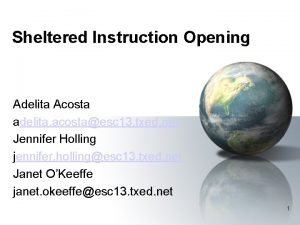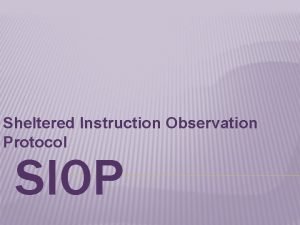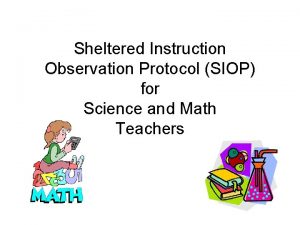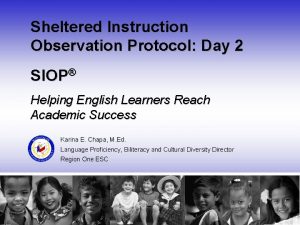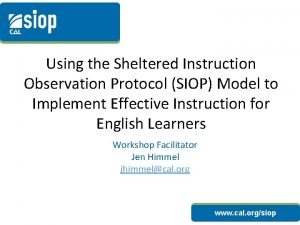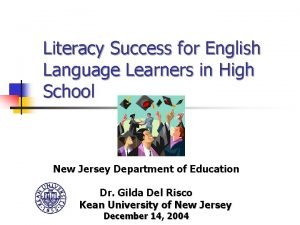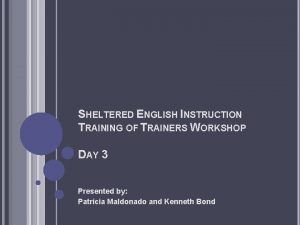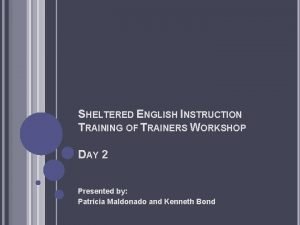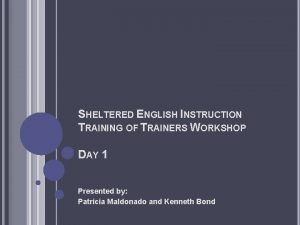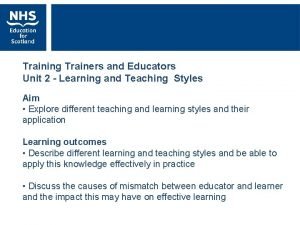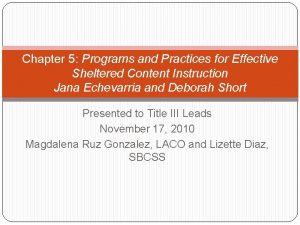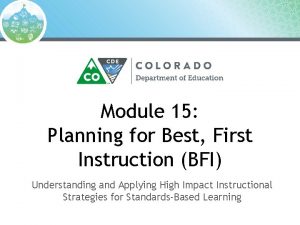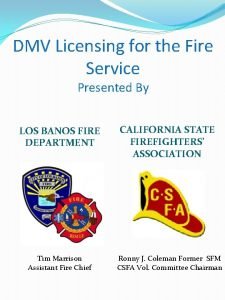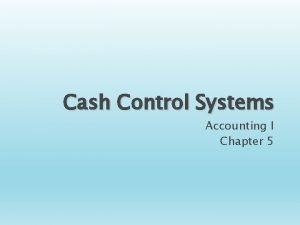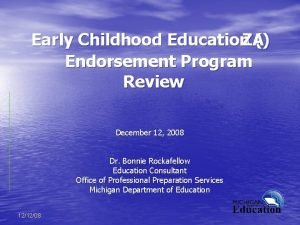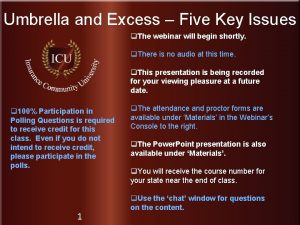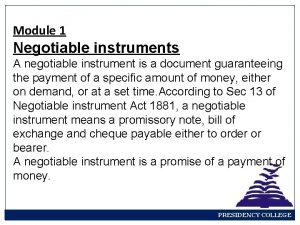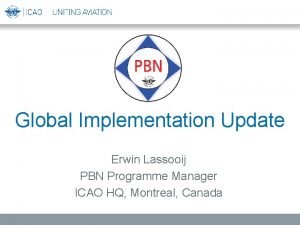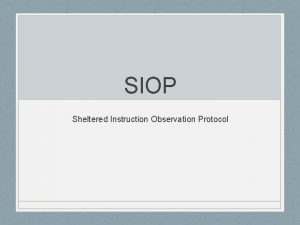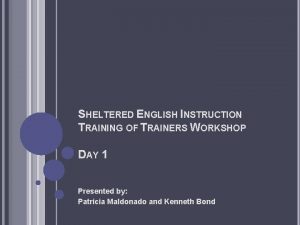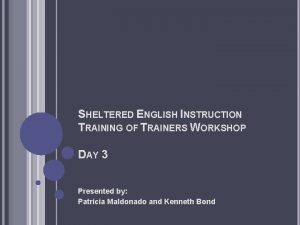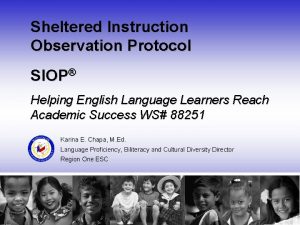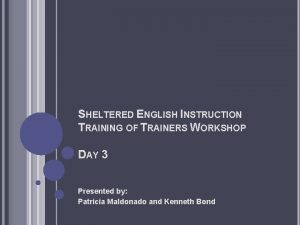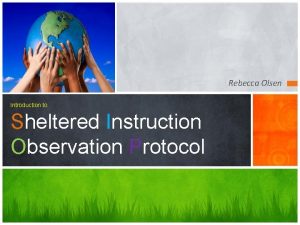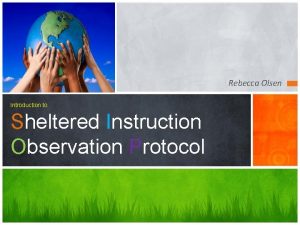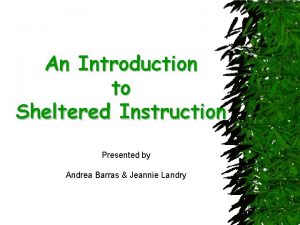Sheltered English Instruction Teacher Endorsement Course Introduction to



































- Slides: 35

Sheltered English Instruction Teacher Endorsement Course Introduction to Course, Policy & Data

Agenda I. Introduction of course II. Purpose of the course III. Method of the course IV. Content of the course V. What this means for us, the ELL teacher VI. Questions/Comments/Ideas Massachusetts Department of Elementary and Secondary Education 2

RETELL Initiative SEI Endorsement Course • Who is designing the course? • Why are they making such a large push now? • Who can take the course? • Who should take the course? • Free vs. Pay / Cohorts 3 Massachusetts Department of Elementary and Secondary Education

Core academic teachers who work with ELLs (SEI Teachers) need the SEI Endorsement Provides a foundation of understanding, knowledge, and skills critical to SEI in core academic areas 4 Massachusetts Department of Elementary and Secondary Education

Types of courses: 1. Administrator course 2. Short Bridge 3. Long Bridge 4. Full Course: 3 Graduate Credits. Massachusetts Department of Elementary and Secondary Education 5

Course Map MODULE A: ELLs: Their World and Second Language Acquisition Process in the SEI Classroom Introduction to Course, Policy, and Data (Face-to-Face; 3 hours) WIDA Plus (Online; 1 hour) Diversity, Cultural & Social Aspects of Teaching ELLs (Face-to-Face; 3 hours) Second Language Acquisition (Online; 1 hour) Overview of SEI (Face-to-Face; 2 hours) MODULE B: Academic Language and Literacy Development in the SEI Classroom VOCABULARY AND DISCOURSE FOR ELLS Vocabulary Part 1 (Online; 1. 5 hours) Vocabulary Part 2 (Face-to-Face; 3 hours) Vocabulary Part 3 (Online; 1 hour) Vocabulary Part 4 (Face-to-Face; 3 hours) READING COMPREHENSION FOR ELLS Reading Part 1 (Online; 1. 5 hours) Writing Part 1 (Online; 1 hour) Reading Part 2 Reading Part 3 (Face-to-Face; 3. 5 hours) (Online; 1 hour) WRITING FOR ELLS Writing Part 2 Writing Part 3 (Face-to-Face; 3. 5 hours) (Online; 1 hour) Instructional Integration (Face-to-Face; 3 hours) ASSESSMENT AND CAPSTONE Capstone I Presentations (Face-to-Face; 3. 5 hours) Reading Part 4 (Face-to-Face; 3 hours) Writing Part 4 (Face-to-Face; 3 hours) Capstone II Presentations (Face-to-Face; 3 hours) Massachusetts Department of Elementary and Secondary Education 6

II. Purpose of the Course Designed to provide ELLs access to effective instruction and close proficiency ACCESS for gaps. Sheltered WIDA English Language Development Standards ELLs Assessment ELL Student Global Development English Instruction (SEI) Endorsement & Course Massachusetts Department of Elementary and Secondary Education 7

8 Massachusetts Department of Elementary and Secondary Education

44 747 2000 -01 49 297 2003 -04 SY 2000: 44, 747 67 567 70, 207 73 217 2010 -11 2011 -12 2012 -13 55 730 2007 -08 % 7 6 SY 2012: 73, 217 Massachusetts Department of Elementary and Secondary Education 9

10 DART for ELLs 2012 Massachusetts Department of Elementary and Secondary Education

Equal access to high quality education Federal laws, guidance, and court cases § Civil Rights Act, 1964 § Equal Educational Opportunity Act (EEOA), 1974 § Lau v. Nichols, (1974) § Castañeda v. Pickard, (1981) § Office of Civil Rights Guidelines § NCLB Title III, 2002 Massachusetts § MA Education Reform Act, 1993 § Ballot Question 2 § Title III priorities in MA § RETELL Regulations Massachusetts Department of Elementary and Secondary Education 11

“Who’s responsible for student learning? Walk into an effective school and ask this question of anyone – a teacher, a student, the principal, a parent volunteer, a secretary – and you’ll get the same answer: I am. ” Massachusetts Department of Elementary and Secondary Education 12

★Design, teach, and reflect on an integrated SEI lesson that EAddresses all four language domains – speaking, listening, reading, and writing EInfuses strategies introduced in the Sheltered English Instruction course EIs consistent with the Massachusetts curriculum and WIDA frameworks 13 Massachusetts Department of Elementary and Secondary Education

For this assignment participants will ESelect one specific class as a focus EDesign a lesson plan w/SEI Lesson Tool ETeach § Lesson to students in their classroom § A component of the Capstone Lesson to course colleagues during one of the two final sessions EWrite a reflection on its planning and implementation. Massachusetts Department of Elementary and Secondary Education 14 14

III. Method of the course Online Face to Face Modeling Strategies Delivering content Classroom application Reflection

IV. Content of Class Getting people to care and understand Teaching them what to do and how to do it. Practicing

Getting People to Care and Understand http: //youtu. be/I 6 Y 0 HAj. LKYI http: //youtu. be/p 7 Ajm. K 77 BWM? t=2 m 22 s Margarita Calderon: Implementing Peer -Assisted Learning Video on You. Tube

Iceberg of Culture Indiana Department of Education �� Office of English Language Learning & Migrant Education �� www. doe. in. gov/englishlanguagelearning The Iceberg Concept of Culture Like an iceberg, the majority of culture is below the surface. food �� dress �� music �� visual arts �� drama �� crafts dance �� literature �� language celebrations �� games courtesy �� contextual conversational patterns �� concept of time personal space �� rules of conduct �� facial expressions nonverbal communication �� body language �� touching �� eye contact patterns of handling emotions �� notions of modesty �� concept of beauty courtship practices �� relationships to animals �� notions of leadership tempo of work �� concepts of food �� ideals of childrearing theory of disease �� social interaction rate �� nature of friendships tone of voice �� attitudes toward elders �� concept of cleanliness notions of adolescence �� patterns of group decision-making definition of insanity �� preference for competition or cooperation tolerance of physical pain �� concept of “self” �� concept of past and future definition of obscenity �� attitudes toward dependents �� problem-solving roles in relation to age, sex, class, occupation, kinship, and so forth Surface Culture Above sea level Emotional load: relatively low Deep Culture Unspoken Rules Partially below sea level Emotional load: very high Unconscious Rules Completely below sea level Emotional load: intense

Culture: Hidden or Apparent “We cannot understand cultures completely, but we can know and accept that we do not understand everything; we can be prepared to learn from as well as with the students in our schools. ” Ovando, Combs, Collier 2006 Do hidden aspects of culture manifest with the ELLs in your school/classroom? 19

Newcomers Different English proficiency levels Grade-level/advanced content knowledge Gifted and talented Special Education Students with Limited or Interrupted Formal Schooling (SLIFE) Massachusetts Department of Elementary and Secondary Education 20

Once they care… What should they do? 1. Understand their student’s proficiency level using WIDA 2. Analyze their class/content texts and materials 3. Use strategies to 1. match content delivery to student proficiency and 2. match assessments to proficiency level of ELL


Core Strategies Vocabulary E 7 Steps ETiered Vocabulary ECognate Awareness ESentence Frames EWord Wheels ELexical Arrays EWord Form Chart EWord Families * More examples in participant manuals 23 Massachusetts Department of Elementary and Secondary Education

Core Strategies Reading EIdentifying and Analyzing Text Features EThink-aloud EReciprocal Teaching EPartner Reading EAnalyzing Text Genres and Organization EClose Reading with Text-dependent Questions EDouble Entry Journals * More examples in participant manuals Massachusetts Department of Elementary and Secondary Education 24

Core Strategies Writing ECut-n-Grow EInformation Gap ELanguage Experience Approach (LEA) ERAFT ERatiocination ERound Table ESentence Combining EWrite-around * More examples in participant manuals Massachusetts Department of Elementary and Secondary Education 25

Interaction Strategies Anticipation Guide Clock Buddies Continuum Divide & Slide Exit Ticket Expert Groups Final Word Protocol Gallery Walk Thinking Notes Graphic Organizers Think-Write. Pair-Share Jigsaw ET-P-S Last One ET-P-Square. Standing S Numbered Turn & Talk Heads Visual Together Quick Write Scaffolding Snowballs Zip Line Massachusetts Department of Elementary and Secondary Education 26

V. What does this mean for us and for content teachers? Clear roles and expectations!!

Requirements for Instruction of ELLS Meaningful Access to Curriculum Sheltered English Instruction (SEI) Differentiated instruction that includes approaches, strategies and methodology that makes the content comprehensible and promotes academic English language development Bilingual or Dual Language Instruction* ESL Instruction Explicit, direct instruction in English to promote English language development T S U M e d i v o pr both! Massachusetts Department of Elementary and Secondary Education 28

English as a Second Language What is ESL? ETaught by a licensed ESL (or ELL) teacher EBased on ESL curriculum Definition: Explicit, EIntegrates language direct instruction in domains: listening, English to promote speaking, reading, & English language writing development EIs for ELLs only Massachusetts Department of Elementary and Secondary Education. 2006 29

NOT! What ideas did your group come up with? Academic support class Special education services An intervention Extra help Homework help Tutorial Taking standard curriculum lesson and helping ELLs through it Massachusetts Department of Elementary and Secondary Education 30

Sheltered English Instruction What is SEI? ECore content teacher EDifferentiated instruction Definition: Differentiated instruction that includes approaches, strategies and methodology that makes the content comprehensible and promotes academic English language development § Listening, speaking, reading, writing ELanguage objectives, content objectives & assessment aligned EIntermediate level & above EAll students will benefit Massachusetts Department of Elementary and Secondary Education. 2006 31

Role of the SEI teacher Expert in content area Responsible for promoting Eacademic concepts through English; Eliteracy development. Uses SEI to Edifferentiate content instruction; Epromote academic concept learning and language development. 32 Massachusetts Department of Elementary and Secondary Education

VI. Follow up questions? Time to look at manual

Readings Menken, K. , & T. Kleyn. 2009. The difficult road for long-term English learners. Supporting English Language Learners De. Capua, A. , &. H. W. Marshall. 2011. Reaching ELLs at risk: Instruction for students with limited or interrupted formal education. Preventing School Failure Belin, Connie and Jacqueline N. Blank. International Center for Gifted Education and Talent Development. 2008. Identifying gifted and talented English language learners, grades K– 12. Massachusetts Department of Elementary and Secondary Education 34

Readings • de Jong, E. J. and C. A. Harper. 2005. Preparing mainstream teachers for English language learners: Is being a good teacher good enough? • Graves, M. , D. August, and M. Carlo. 2011. Teaching 5, 000 words. In Better Evidence-based Education.
 Sheltered english instruction
Sheltered english instruction Sheltered instruction observation protocol
Sheltered instruction observation protocol Pros and cons of siop model
Pros and cons of siop model Sheltered instruction
Sheltered instruction Sheltered instruction observation protocol
Sheltered instruction observation protocol Sheltered instruction
Sheltered instruction Teacher leader endorsement illinois
Teacher leader endorsement illinois Individualized instruction vs differentiated instruction
Individualized instruction vs differentiated instruction Direct instruction strategies
Direct instruction strategies Sheltered trainer
Sheltered trainer Sheltered trainer
Sheltered trainer Sheltered 2 trainer
Sheltered 2 trainer Sheltered 2 trainer
Sheltered 2 trainer Sheltered industry
Sheltered industry Sdaie definition
Sdaie definition What is the first instruction of the teacher
What is the first instruction of the teacher Firefighter endorsement dmv
Firefighter endorsement dmv Catastrophic risk protection endorsement
Catastrophic risk protection endorsement How to sign a check over
How to sign a check over Shampoo advertisement analysis
Shampoo advertisement analysis What is practical endorsement
What is practical endorsement Za zs endorsement
Za zs endorsement Non concurrency endorsement
Non concurrency endorsement Difference between special crossing and general crossing
Difference between special crossing and general crossing Pbn endorsement
Pbn endorsement An endorsement indicating a new owner of a check.
An endorsement indicating a new owner of a check. Art and humanities endorsement
Art and humanities endorsement An endorsement indicating a new owner of a check.
An endorsement indicating a new owner of a check. Foundation high school program with endorsement
Foundation high school program with endorsement Art endorsement
Art endorsement Awaiting endorsement
Awaiting endorsement Celebrity endorsement
Celebrity endorsement Home sharing host activities amendatory endorsement
Home sharing host activities amendatory endorsement Arts and humanities endorsement
Arts and humanities endorsement Erf requirements for master teacher
Erf requirements for master teacher Good afternoon teacher.
Good afternoon teacher.
